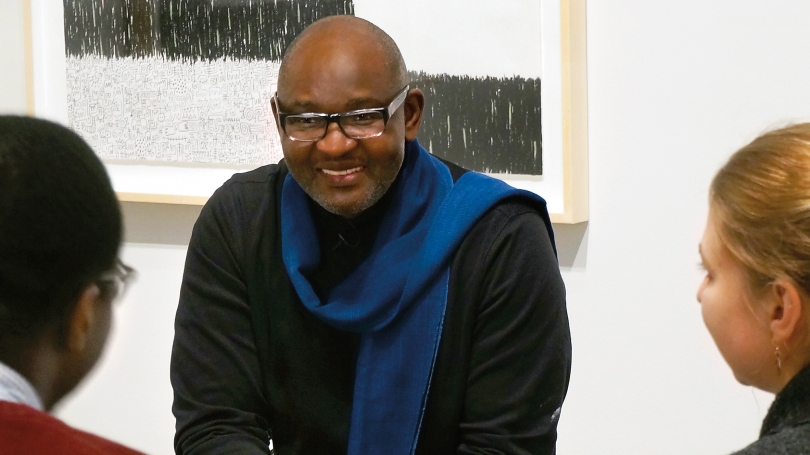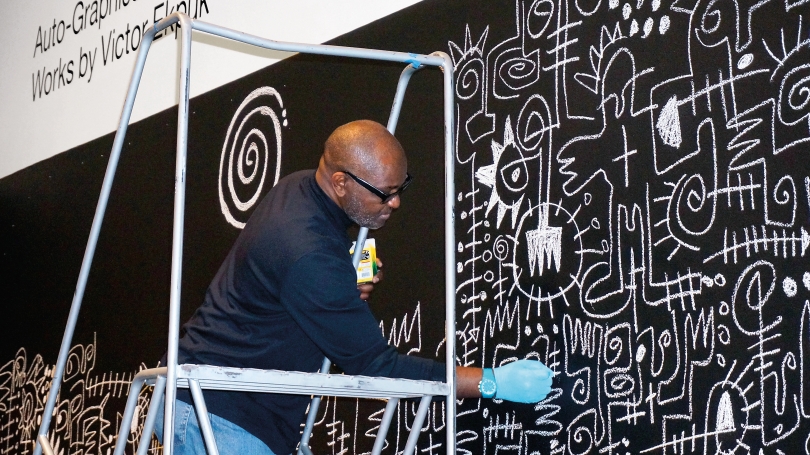Victor Ekpuk’s ephemeral wall drawings demonstrate the artist’s site-specific adaptation of his drawing approach to architectural working surfaces. Created without preliminary sketches or pre-formed ideas, the murals emerge out of the physical spaces they ultimately occupy, functioning much like the symbolic forms that mark sacred spaces and shrine walls in traditional societies in Africa. In this interview conducted in advance of his visit to Dartmouth, Ekpuk discusses his wall drawings with Curator of African Art Ugochukwu-Smooth Nzewi.
Ugochukwu-Smooth Nzewi (SN): We are very happy to have your exhibition Auto-Graphics on view at the Hood. We are even more excited that you are creating a wall drawing—the largest of your wall drawings to date—in Lathrop Gallery in conjunction with this exhibition. It is my understanding that it was the context of an earlier exhibition in Amsterdam that sparked what has become a critical aspect of your practice, the ephemeral wall drawings. Can you talk about this experience?
Victor Ekpuk (VE): During a 2008 artist-in-residency program at Thami Mnyele Foundation in the Netherlands, I was invited to participate in an exhibition to mark the launching of ZAM magazine. The exhibition included works of celebrated South African artist Marlene Dumas as well as other artists and poets from Africa. I proposed to do a mural drawing based on the memory of my life in the Netherlands. Amsterdam Central was an encapsulation of my experience as a transient visitor there. I was intrigued by the idea that the drawing that I would spend several hours making on a gallery wall would eventually be erased to make space for another artwork. I saw this as a metaphor for life itself. The knowledge that I exist at one moment in time only to exit for something else to fill the space that I once occupied was a very humbling realization. On one level, Amsterdam Central was just an expression of the essence of the Netherlands from my perspective as a visitor. On another, I was probing an inner dialogue with existential reality.
SN: Memory is central to your practice and even more fundamental to your wall drawings, which is why you call them “drawing memories.” You have framed memory as received, imagined, transposed, and appropriated. Why does memory hold such fascination for you?
VE: I believe that our self-consciousness is borne from memory. Through selfconsciousness we form our identities. I observe identity as an ephemeral condition that is always in flux. As you rightly noted, memories are constantly being imagined, transposed, and appropriated. So in “drawing memories,” I am trying to capture these various selves in my stream of consciousness. I am very intrigued by the realization that essentially we are all a sum of different parts that are shaped by circumstances. There is always recognition of some personal memory in the collective. Because it is, after all, a human story. Some these memories are what have shaped my life or the lives of people I have come in contact with.
SN: You once told me that your creative process involves moments of quietude in which you dig deep into your memory bank for visual clarity and intellectual materials to work with. How does the creative process involved in the making of the wall drawings differ from your regular studio process?
VE: The process for drawing on the wall differs, in some ways, from studio practice because I prefer it to be spontaneous. I usually prefer not to think about what I am going to draw until I am in the space, at which time I let the space and what I feel at that moment determine what direction the composition will take.
SN: Your wall drawings do not exactly present cohesive narratives or offer formal points of entry for the viewer, although one must admit that there is a logic to the way you amass the scriptlike symbols on the wall surface. Is that a reflection of your understanding of the way memory works?
VE: While drawing, my hand responds to a stream of consciousness, a flow of images from my mind. During this instant I let go and lose myself in the moment. Yes, in a way that’s how our conscious minds work: we exercise our abilities to sift through memories and focus on those that are relevant to immediate attention.
SN: You have also described your wall drawings as performance. Is this because you draw upon nsibidi, the autochthonous body of symbols used in visual and gestured communication by the Ekpe secret society in southeastern Nigeria and southwestern Cameroon?
VE: Yes, the performative and the ephemeral aesthetics of nsibidi remain strong influences on my artistic process and production. In the outward display of knowledge, members of the secret society that practice nsibidi usually engage in “mbre,” meaning play of nsibidi. It involves challenging one another to decipher coded graphic signs that are marked on the ground. In other instances, nsibidi signs are used as coded messages, marked either on the ground or on objects, and sometimes as arrangements of objects. It is worth noting that in all of these instances, the signs are always ephemeral. They are often wiped off once the play is over or the message has been received.
SN: Although nsibidi was a point of departure for you at the beginning of your practice, to what extent do you still rely on its repertoire of pictographic and ideographic scripts in your wall drawings?
VE: I’ve found myself using less of nsibidi in my work in general. Having imbibed the nsibidi aesthetic philosophy of focusing on the essence of form or thought to communicate ideas, application of this principle comes in very handy when I approach a composition or design idea. As a means to fully engage this aesthetic philosophy, I made the series of large drawings called Composition Series, which are on view as part of Auto-Graphics, where I explored nsibidi symbols not for their meaning but for their aesthetics and abstract forms.
SN: How many of these wall drawings have you made and how do they differ from each other?
VE: Starting from my first drawing in Amsterdam in 2008 to what I will create at the Hood Museum of Art, I will have made six wall drawings in all. Mickey on Broadway, my second mural, was created in a Washington, D.C., gallery in 2011. It considered my identity as both African and American. It was partly mixed media, and included five Mickey Mouse–shaped plastic bowls placed above African-inspired forms. Meditations on Memories, also created in a gallery in 2011, was more abstract and contemplative. It was the first time I worked strictly with white chalk on a black wall. This was also the first time I was actively involved in the erasure of my wall drawing. In other works—such as Drawing Memories at Appalachian State University in 2013, and an untitled drawing at Krannert Art Museum and Ode to Joy at Arkansas Art Center, both in 2014—I was more interested in capturing the intrinsic aesthetics of objects and forms. Ode to Joy, a dialogue with Beethoven’s Symphony No. 9 in D Minor, Op. 125, was my first attempt at drawing music. With headphones on my ears, I attempted to translate the imagery formed from the elation I felt. I was like the conductor of an orchestra, enthralled in raptures of violins, kettledrums, cellos, trumpets, cymbals, and the roaring voices in harmonious chants as the crescendos built and ecstasies exploded in my heart.
The exhibition Auto-Graphics: Works by Victor Ekpuk, on view through August 2, was organized by Krannert Art Museum, University of Illinois at Urbana-Champaign, and curated by Allyson Purpura. It was partially supported by a grant from the Illinois Arts Council Agency. The exhibition’s presentation at the Hood Museum of Art, Dartmouth College, was generously supported by the Leon C. 1927, Charles L. 1955, and Andrew J. 1984 Greenebaum Fund and the Cissy Patterson Fund.

